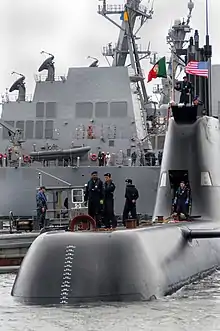Portugal–United States relations
Portugal–United States relations are bilateral relations between Portugal and the United States.
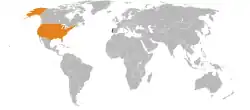 | |
Portugal |
United States |
|---|---|
| Diplomatic mission | |
| Embassy of Portugal, Washington, D.C. | Embassy of the United States, Lisbon |
History
.jpg.webp)
Despite various attempts to set up colonies in Newfoundland and Labrador and Nova Scotia, the Kingdom of Portugal never held any long-lasting or significant colonies in North America due to the 1494 Treaty of Tordesillas, which stipulated that the Portuguese were only allowed to set up colonies in the Old World (aside from Brazil, which the treaty failed to account for), leaving the New World open to Spanish colonization. Despite the lack of colonies, a small amount of Portuguese individuals did settle in North America prior to the 19th century.[1]

Unlike other European colonial powers such as France and Spain, Portugal did not intervene on behalf of the United States during the American Revolutionary War. This was because of the aforementioned lack of Portuguese colonies in North America and also because of the historic alliance between Portugal and Britain, dating back to the 14th century. Portugal remained neutral throughout the conflict, eventually joining the First League of Armed Neutrality, a league of European states organized by Catherine the Great of Russia to protect neutral shipping, which was often interrupted and seized by the Royal Navy during the war. While the Portuguese military did not participate in the war, some of the aforementioned Portuguese settlers in the Thirteen Colonies did fight, such as the "Virginia Giant" Peter Francisco, a soldier of the Continental Army who was born in the Azores.
In 1791, Portugal became the first neutral nation to establish diplomatic ties with the United States, leading to the arrival of an American legation headed by David Humphreys in Lisbon.[2] Consular relations with the Portuguese island territories of Madeira and the Azores were established in 1790 and 1795 respectively.[2] When the Portuguese court fled to Brazil during the Napoleonic Wars, the American legation followed the court to Rio de Janeiro in 1810 and returned with it to Lisbon in 1822.[2]
The U.S. and Portugal fought together in the First Barbary War (1801–1805) against the Barbary corsairs in an effort to reduce piracy and disruption of trade on the Mediterranean Sea.[3]
Increased Portuguese immigration to the United States began in the early nineteenth century. Approximately 70 percent of these immigrants came from the Azores, with the remainder mostly coming from Madeira and Cape Verde,[1] with very few of them coming from the Portuguese mainland. Most of these Portuguese immigrants settled in New England and ended up working in the whaling industry.[1] The involvement of Portuguese immigrants in the whaling trade also led Portuguese American communities to spring up in the San Francisco Bay Area in California and in Hawaii (see also Portuguese immigration to Hawaii).[1] Some Portuguese immigrants settled in cities further inland, such as Springfield, Illinois.[4] Today, there are over one million Americans of Portuguese descent. While prolific in some areas, Portuguese immigration was comparatively tiny when compared with the large number of German and Irish immigrants that came to the United States.
The Portuguese government favored the Union during the American Civil War, providing assistance to the Union Navy during the conflict.[5] Due to settling primarily in New England, most Portuguese Americans were Union soldiers.[5]
In 1911, the United States declared its support of the 5 October 1910 revolution that abolished the Portuguese Monarchy and replaced it with the First Portuguese Republic.[6]
In 1917, both Portugal and the United States joined World War I on the side of the Allies. During World War II, Portugal remained neutral until 1944, when it allowed the United States to establish a military base in the Azores. Both countries remained on the same side during the Cold War, with both Portugal and the United States becoming founding members of the North Atlantic Treaty Organization (NATO) in 1949.
The harmonious relationship between Portugal and the United States was strained during the 1960s and 70s. Amid a wider global trend of decolonization, the Portuguese colonies of Angola, Mozambique, and Guinea-Bissau, all in Africa, began to demand independence from Portugal. The strain in relations was caused by the United States declaring their support for these independence movements, a move which greatly angered the Portuguese government.[7] Following the Portuguese Colonial War, Angola, Mozambique, and Guinea-Bissau all gained independence. The revolution brought down the dictatorial Estado Novo regime that had ruled over Portugal since 1933, beginning the country's peaceful transition towards democracy and allowing Portuguese-U.S. relations to be repaired.
In 2017 the Portuguese Minister of National Defence, José Alberto Azeredo Lopes and the Ambassador of the United States in Portugal, Robert A. Sherman, sign a new deal with the aim of strengthening cooperation in search and rescue missions in North part of Atlantic Ocean. On the US side, maritime and air search and rescue will be the responsibility of the United States Coast Guard, on the Portuguese side it will be the responsibility of the Portuguese Navy and Portuguese Air Force.[8]
Military
Since the Carnation Revolution and the end of the Cold War, Portugal and the United States have remained close allies, fighting together in the NATO intervention in Bosnia and Herzegovina, the NATO intervention in Kosovo, the Iraq War, and the War in Afghanistan.
The defense relationship between the United States and Portugal is centered on the 1995 Agreement on Cooperation and Defense (ACD). For 50 years, Lajes Field in the Azores has played an important role in supporting U.S. military aircraft (its importance such that the US had a contingency plan in 1975 to stimulate Azores independence in the event of a Communist takeover of Portugal[9]). Most recent missions are engaged in counter-terrorism and humanitarian efforts, including operations in Afghanistan and Iraq. Portugal also provides the United States access to Montijo Air Base and a number of ports. Portugal was also, along with the United States, one of the founding members of NATO.
Portugal defines itself as "Atlanticist" emphasizing its support for strong European ties with the United States, particularly on defense and security issues. The Government of Portugal has been a key ally in US, supporting efforts in Iraq, and hosting the Azores Summit, where on March 16, 2003, Spanish Prime Minister, José María Aznar, UK Prime Minister, Tony Blair, President of the United States George W. Bush, and Prime Minister of Portugal, José Manuel Durão Barroso discussed the invasion of Iraq.[10][11]
The Portuguese Marine Corps of the Portuguese Navy together with the United States Marine Corps, has carried out several joint military exercises in the last years.[12][13][14]
The annual Real Thaw military exercise of the Portuguese Air Force counts with the participation of the American Air Force since 2013.[15]
The United States Department of Defense has supported the last depolyments of Portuguese Army soldiers during the Resolute Support Mission in Afghanistan, with 15 International MaxxPro and 7 Oshkosh M-ATV to protect the Kabul International Airport.[16][17]
Over the last few years, the Portuguese and American military have carried out several missions in Eastern Europe, namely in Romania and Lithuania.[18][19]
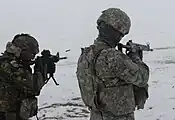
_JP7575154.jpg.webp)
 Portuguese soldiers hook their Panhard VBL to an UH-60 Blackhawk of the 224th Aviation Regiment.
Portuguese soldiers hook their Panhard VBL to an UH-60 Blackhawk of the 224th Aviation Regiment._arrives_at_Naval_Station_Norfolk.jpg.webp) Portuguese Submarine NRP Tridente (S160) at Naval Station Norfolk.
Portuguese Submarine NRP Tridente (S160) at Naval Station Norfolk.
Economic
.png.webp)
The United States of America stands out as one of Portugal's main trading partners, and is Portugal's largest trading partner outside the European Union.
According to data from the National Institute of Statistics, in 2022 the USA was the 4th customer of Portuguese exports, with a share of 7% of the total, and occupied the 8th position in terms of imports (3.28% of the total).
In 2021, the value of portuguese exports to United States was 4,490 million dollars and that of imports reached 2,340 million dollars.[20]
Most of the products exported by Portugal to the United States of America are mineral fuels, machinery, chemical products, plastics and rubber, textile materials, wood and cork, common metals and minerals and ores. Conversely, groups of products made up of mineral fuels, agricultural products, machinery and apparatus, vehicles and other transport material, chemical products, plastics and rubber, optical and precision instruments, and common metals stand out in terms of American exports to Portugal.
The Government of Portugal is encouraging greater bilateral investment. US firms play some significant roles in the pharmaceutical, computer, and retail sectors in Portugal, particularly in Lisbon, but their involvement in the automotive sector has sharply declined in recent years.
Official meetings
.jpg.webp)
.png.webp)

Presidential visits from United States to Portugal[21][10]
- President Dwight D. Eisenhower (1960)
- President Jimmy Carter (1980)
- President Ronald Reagan (1985)
- President George Bush (1994)
- Vice President Al Gore (1996)
- President Bill Clinton (2000)
- President George W. Bush (2003)
- President Barack Obama (2010)
Presidential visits from Portugal to United States[21]
- President António Ramalho Eanes (1978)
- Prime Minister Francisco Pinto Balsemão (1982)
- President António Ramalho Eanes (1983)
- President Mário Soares (1987)
- President Mário Soares (1989)
- President Mário Soares (1993)
- President Jorge Sampaio (2000)
- President Aníbal Cavaco Silva (2007)
- President Aníbal Cavaco Silva (2011)
- President Aníbal Cavaco Silva (2014)
- President Aníbal Cavaco Silva (2015)
- President Marcelo Rebelo de Sousa (2016)
- President Marcelo Rebelo de Sousa and Prime Minister António Costa (2018)
- President Marcelo Rebelo de Sousa (2022)
Resident diplomatic missions
- Portugal has diplomatic missions in:[22]
- Washington, D.C.. (Embassy)
- Boston (Consulate-General)
- New York City (Consulate-General)
- Newark (Consulate-General)
- San Francisco (Consulate-General)
- New Bedford (Consulate)
- Providence (Vice-Consulate)
- Honolulu (Honorary Consulate)
- Houston (Honorary Consulate)
- Indianapolis (Honorary Consulate)
- Los Angeles (Honorary Consulate)
- Miami (Honorary Consulate)
- New Orleans (Honorary Consulate)
- Phoenix (Honorary Consulate)
- San Diego (Honorary Consulate)
- San Juan de Puerto Rico (Honorary Consulate)
- Tulare (Honorary Consulate)
- Waterbury/Naugatuck (Honorary Consulate)
- United States has diplomatic missions in:[23]
- Lisbon (Embassy)
- Ponta Delgada (Consulate)
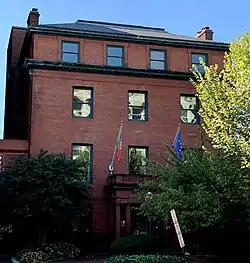 Embassy of Portugal in Washington, D.C.
Embassy of Portugal in Washington, D.C._-1.jpg.webp) Consulate-General of Portugal in San Francisco
Consulate-General of Portugal in San Francisco.jpg.webp) Embassy of the United States in Lisbon
Embassy of the United States in Lisbon
Country comparison
| Official name | Portuguese Republic | United States of America |
|---|---|---|
| Coat of arms | 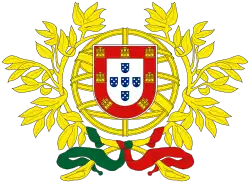 |
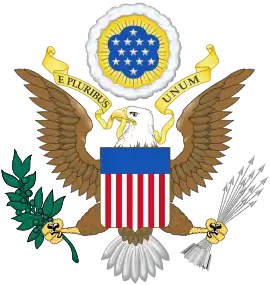 |
| Flag | 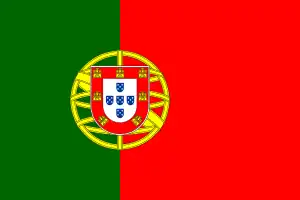 |
 |
| Time zones | 2 | 9 |
| Population | 10,467,366 | 329,562,579 |
| Area | 92,226 km2 (35,609 sq mi) | 9,833,634 km2 (3,796,787 sq mi) |
| Population density | 111/km2 (290/sq mi) | 35/km2 (87.4/sq mi) |
| Capital | Lisbon | Washington, D.C. |
| Largest city | Lisbon – 548,703
Sintra – 388,767 Vila Nova de Gaia – 307,563 |
New York City – 8,600,710
Los Angeles – 3,999,759 Chicago – 2,716,450 |
| Established | June 24, 1128 (Declaration)
October 5 1143 (Recognition) |
July 4, 1776 (Declaration)
September 3, 1783 (Recognition) |
| Government | Unitary semi-presidential republic | Federal presidential constitutional republic |
| Legislature | Assembly of the Republic | United States Congress |
| Military | Portuguese Armed Forces | United States Armed Forces |
| Current Leaders | President: Marcelo Rebelo de Sousa | President: Joe Biden |
| Prime Minister: António Costa | Vice President: Kamala Harris | |
| National language | Portuguese | English (de facto)[24] |
| Religion | 80.2% Catholic
14.09% Irreligion 4.57% Other form of Christianity 1.14% Other Religions |
48.5% Protestant
22.7% Catholic 1.8% Mormon 21.3% Irreligion 2.1% Judaism 2.7% Other religions[25] |
| Ethnic groups | 94.8% Portuguese
5.2% Immigrants |
72.4% European American
12.6% African American 4.8% Asian American 0.9% American Indian and Alaska Native 0.2% Native Hawaiian and Pacific Islander 6.2% Other |
| GDP (nominal) | US$267,721 billion ($26,012 per capita) | US$21.433 trillion ($67,427 per capita) |
See also
References
- "Portuguese Settlement in the United States". Library of Congress. Retrieved June 17, 2020.
- "A Guide to the United States' History of Recognition, Diplomatic, and Consular Relations, by country, since 1776: Portugal". Office of the Historian. Retrieved June 17, 2020.
- "The Barbary Wars 1801–1805 and 1815". Veterans Museum at Balboa Park. Retrieved June 17, 2020.
- "Protestant Exiles from Madeira in Illinois". Library of Congress. Retrieved June 17, 2020.
- "Portugal and the U.S. Civil War". Portuguese Historical Museum. Retrieved June 17, 2020.
- "EUA reconhecem a República". Fundação Mário Soares. Retrieved September 23, 2010.
- "Portugal-US Relations". Global Security.org. Retrieved June 17, 2020.
- "Portugal e EUA assinam acordo sobre busca e salvamento marítimo e aéreo". www.portugal.gov.pt. Retrieved April 1, 2023.
- Agence France Presse, Raw Story, November 19, 2010, US had plans to ‘take over’ Azores in 1975
- "The President's News Conference With Prime Minister Jose Manuel Durao Barroso of Portugal, President Jose Maria Aznar of Spain, and Prime Minister Tony Blair of the United Kingdom in the Azores, Portugal | The American Presidency Project". www.presidency.ucsb.edu. Retrieved April 2, 2023.
- Lusa (March 16, 2008). "Início da guerra no Iraque foi ditado há cinco anos na Cimeira das Lajes". PÚBLICO (in Portuguese). Retrieved April 2, 2023.
- "Bilateral Military Training with U.S. Marines and Portuguese Fuzileiros".
- "Fuzileiros e Marines norte-americanos treinam em Portugal". Marinha (in European Portuguese). Retrieved March 31, 2023.
- "Fuzileiros portugueses e Marines norte-americanos realizam exercício conjunto". Marinha (in European Portuguese). Retrieved March 31, 2023.
- "REAL THAW 13 sets aim for interoperability". U.S. Air Forces in Europe & Air Forces Africa. Retrieved March 31, 2023.
- "Portugal to field US military MRAPs in Afghanistan | Jane's 360". February 15, 2018. Archived from the original on February 15, 2018. Retrieved March 31, 2023.
- "Militares no Afeganistão recebem 4 novas viaturas de combate blindadas". Portal da Defesa na Internet (in European Portuguese). Retrieved March 31, 2023.
- "US Army, NATO Allies complete Exercise Justice Eagle 22". www.army.mil. Retrieved October 9, 2023.
- "Lithuania hosts multinational squad competition". www.army.mil. Retrieved October 9, 2023.
- "United States (USA) and Portugal (PRT) Trade | OEC". OEC – The Observatory of Economic Complexity. Retrieved March 31, 2023.
- "Estados Unidos da América". Portal Diplomático (in European Portuguese). Retrieved April 2, 2023.
- "Estados Unidos da América". Portal das Comunidades Portuguesas (in European Portuguese). Retrieved July 6, 2023.
- Embassy of the United States in Lisbon
- "U.S. facts and figures | USAGov". www.usa.gov. Retrieved April 9, 2023.
- Newport, Frank (December 22, 2017). "2017 Update on Americans and Religion". Gallup. Retrieved February 25, 2019.
- "2010 Census Data". U.S. Census Bureau. Archived from the original on January 2, 2011. Retrieved March 29, 2011.
![]() This article incorporates public domain material from U.S. Bilateral Relations Fact Sheets. United States Department of State.
This article incorporates public domain material from U.S. Bilateral Relations Fact Sheets. United States Department of State.
Further reading
- Marcos, Daniel. "Between the Atlantic and the Empire: NATO as a framework for Portuguese–American relations in early Cold War (1949–1957)." Journal of Transatlantic Studies 12.3 (2014): 324–341.
External links
![]() Media related to Relations of Portugal and the United States at Wikimedia Commons
Media related to Relations of Portugal and the United States at Wikimedia Commons
